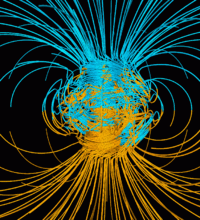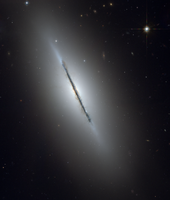
Magnetic Field Amplification in Galaxy Clusters and Its Simulation
Sign Up to like & getrecommendations! Published in 2018 at "Space Science Reviews"
DOI: 10.1007/s11214-018-0556-8
Abstract: We review the present theoretical and numerical understanding of magnetic field amplification in cosmic large-scale structure, on length scales of galaxy clusters and beyond. Structure formation drives compression and turbulence, which amplify tiny magnetic seed… read more here.
Keywords: magnetic field; simulation magnetic; galaxy clusters; field amplification ... See more keywords

Diffuse Radio Emission from Galaxy Clusters
Sign Up to like & getrecommendations! Published in 2019 at "Space Science Reviews"
DOI: 10.1007/s11214-019-0584-z
Abstract: In a growing number of galaxy clusters diffuse extended radio sources have been found. These sources are not directly associated with individual cluster galaxies. The radio emission reveal the presence of cosmic rays and magnetic… read more here.
Keywords: radio emission; cluster radio; radio; galaxy clusters ... See more keywords

Correlations in the matter distribution in CLASH galaxy clusters
Sign Up to like & getrecommendations! Published in 2018 at "Physics of the Dark Universe"
DOI: 10.1016/j.dark.2019.100342
Abstract: Abstract We study the total and dark matter (DM) density profiles as well as their correlations for a sample of 15 high-mass galaxy clusters by extending our previous work on several clusters from Newman et… read more here.
Keywords: clash; density; physics; galaxy clusters ... See more keywords

Radial metal abundance profiles in the intra-cluster medium of cool-core galaxy clusters, groups, and ellipticals
Sign Up to like & getrecommendations! Published in 2017 at "Astronomy and Astrophysics"
DOI: 10.1051/0004-6361/201630075
Abstract: The hot intra-cluster medium (ICM) permeating galaxy clusters and groups is not pristine, as it has been continuously enriched by metals synthesised in Type Ia (SNIa) and core-collapse (SNcc) supernovae since the major epoch of… read more here.
Keywords: snia sncc; clusters groups; abundance; galaxy clusters ... See more keywords

Signatures of quenching in dwarf galaxies in local galaxy clusters
Sign Up to like & getrecommendations! Published in 2021 at "Astronomy and Astrophysics"
DOI: 10.1051/0004-6361/202039408
Abstract: The transformation of late-type galaxies has been suggested as the origin of early-type dwarf galaxies in galaxy clusters. Venhola et al. analysed correlations between colour and surface brightness for galaxies in the Fornax cluster binned… read more here.
Keywords: surface brightness; galaxy clusters; type galaxies; cluster ... See more keywords

PACT. II. Pressure profiles of galaxy clusters using Planck and ACT
Sign Up to like & getrecommendations! Published in 2021 at "Astronomy and Astrophysics"
DOI: 10.1051/0004-6361/202040213
Abstract: The pressure of hot gas in groups and clusters of galaxies is a key physical quantity, which is directly linked to the total mass of the halo and several other thermodynamical properties. In the wake… read more here.
Keywords: pressure profiles; act; profiles galaxy; pact pressure ... See more keywords

Statistical description of galaxy clusters in Finzi model of gravity
Sign Up to like & getrecommendations! Published in 2022 at "Physica Scripta"
DOI: 10.1088/1402-4896/acd5cd
Abstract: We exploit a new theory of gravity proposed by Finzi, which gives stronger interaction at large scales, to study the thermodynamic description of galaxy clusters. We employ a statistical model to deduce various thermodynamics equations… read more here.
Keywords: gravity; galaxy clusters; model; description galaxy ... See more keywords

Detection of virial shocks in stacked Fermi-LAT galaxy clusters
Sign Up to like & getrecommendations! Published in 2018 at "Journal of Cosmology and Astroparticle Physics"
DOI: 10.1088/1475-7516/2018/10/010
Abstract: In the hierarchical paradigm of structure formation, galaxy clusters are the largest objects ever to virialize. They are thought to grow by accreting mass through large scale, strong virial shocks. Such a collisionless shock is… read more here.
Keywords: gamma ray; detection virial; fermi lat; virial shocks ... See more keywords

Encounters of merger and accretion shocks in galaxy clusters and their effects on intracluster medium
Sign Up to like & getrecommendations! Published in 2020 at "Monthly Notices of the Royal Astronomical Society"
DOI: 10.1093/mnras/staa1013
Abstract: Several types/classes of shocks naturally arise during formation and evolution of galaxy clusters. One such class is represented by accretion shocks, associated with deceleration of infalling baryons. Such shocks, characterized by a very high Mach… read more here.
Keywords: accretion shocks; merger; accretion; intracluster medium ... See more keywords

Comptonization of CMB in galaxy clusters. Monte Carlo computations
Sign Up to like & getrecommendations! Published in 2020 at "Monthly Notices of the Royal Astronomical Society"
DOI: 10.1093/mnras/staa3010
Abstract: The problem under consideration is to determine the change of the Cosmic Microwave Background (CMB) spectral shape due to the thermal Sunyaev-Zeldovich effect. We numerically model the spectral intensity of the CMB radiation Comptonized by… read more here.
Keywords: clusters monte; monte carlo; cmb; cmb galaxy ... See more keywords

Measuring the total infrared light from galaxy clusters at z = 0.5–1.6: connecting stellar populations to dusty star formation
Sign Up to like & getrecommendations! Published in 2020 at "Monthly Notices of the Royal Astronomical Society"
DOI: 10.1093/mnras/staa3357
Abstract: Massive galaxy clusters undergo strong evolution from z~1.6 to z~0.5, with overdense environments at high-z characterized by abundant dust-obscured star formation and stellar mass growth which rapidly give way to widespread quenching. Data spanning the… read more here.
Keywords: galaxy; mass; star formation; galaxy clusters ... See more keywords